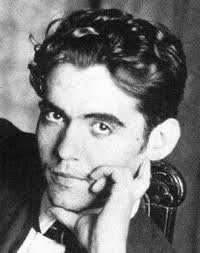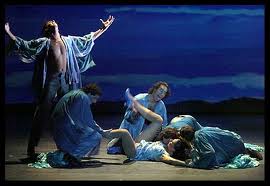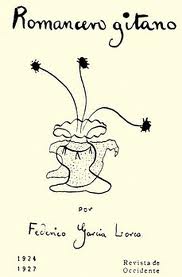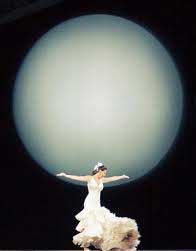Romancero Gitano

The 'Romancero Gitano' (Gypsy Ballads) is a book of poems by Federico Garcia Lorca, published in 1928. It's made up of 18 ballads revolving around the topic of the gypsy life style, culture and customs. The ballads reflect the pains of the gypsy people who live in the margins of society and are constantly persecuted by the authorities, and the fight against them and their repressive laws.
The Romancero Gitano is Federico Garcia Lorca's most famous book od poems, and for this it's studied by everyone who wants to study Spanish. It's also the most bought book of Spanish poems, and many bands have used them as lyrics for their songs.
Romancero Gitano - Structure and topics
Garcia Lorca chooses to talk about the gypsies because he thinks they represent the Andalusian culture and customs in its purest form.
The poems in the Romancero Gitano are mainly ballads, all of them joined by the style and the topics they treat. The poems can be grouped by the different thematics: lyricism and women; women and their dilemmas; the three mythical Archangels; epic and men (divided into extreme situations and the destruction of the Andalusian mythical world); and legends and traditions.
- Lyricism and women
The first three poems ('Romance de la luna, luna'; 'Preciosa y el aire'; 'Reyerta') talk about the confrontations between the gypsy world and several different mythical forces: in the first poem with death, represented by the moon; the second between desire and the masculine instinct, represented by the wind; in the third poem the confrontation is against the fights and violence of the gypsies. - Women and their dilemmas
The 'Romance Sonámbulo' tells the story of a gypsy smuggler who returns home and finds his wife dead by the despair of waiting for him; in 'Monja gitana' the main character is a nun debating between her faith in God and her freedom instincts; 'Casada infiel' is about a married woman who gives up her fidelity, guide by her instincts. In 'Romance de la pena negra', Garcia Lorca expresses the tragic feeling of the gypsy life through the deep sadness of Soledad Montoya. - The three mythical Archangels
Each of the mythical gypsy Archangels represents an emblematic city in Andalusia: San Miguel represents Granada, San Rafael represents Córdoba, and San Gabriel represents Seville. Their placement answers to a geographic order. The poems are complex and hermetic, with a large number of metaphors. - Epic and men
These poems can be divided in two:
The first part is composed of 4 poems in which the gypsy character has to face extreme situations. 'Prendimiento de Antoñito el Camborio' and 'Muerte de Antoñito el Camborio' talk about the gypsy dignity: a gypsy is humiliated and murdered, victmim to the jealousy he provoques among his family due to his great qualities. 'Muerto de amor' tells the story of the death of a young gypsy who dies of sadness from a broken heart. 'Romance del emplazado' narrates a gypsy's obsession about a predicted omen of death, which ends up being true. The second part is the 'Romance de la Guardia Civil', which shows the destruction of the mythical Andalusian world, always under the menace of misterious forces that try to destroy it. In this case, this desctructive force is symbolized by the Guardia Civil who enters the village breaking and killing anything and anyone they find. - Legends and traditions
The last three poems deal with three legends with different traditions that Garcia Lorca changes slightly to adapt them to the gypsy world, to reinforce the mythical and universal projection of the gypsies. In 'El Martirio de Santa Olalla' Lorca turns back to the Early Christian period to tells the story of a young man persecuted by the Romans, the same thing that happened to the gypsies with the Guardia Civil. 'Burla a Don Pedro a caballo' takes us to the literary world; it's a poem about oblivion and solitude, represented in the lack of love suffered by a knight. 'Thamar y Amnon' is based on the Book of Samuel, a biblical story that narrates the love story of an incest relationship between Thamar and her brother Amnon.

Romancero Gitano - Recurring characters

The 'Romancero Gitano' has many different characters, but they are not the typical characters (by this we mean people) but 'abstract' characters or topics: violence, death, love, etc.
Violence and death: The gypsies's customs clash with those of the conventional world, and this provokes tensions and the shedding of blood. The consequence to this is normally death.
Love: Bound to death and violence, it's a source of frustration. This love is doomed to failure, and appears in the form of a carnal and disturbing eroticism.
The gypsy: The gypsies in Lorca's works are not folkloric, but a symbol of the Andalusian culture. It represents the social margination and the exotic, the natural impulses of men. They're also the archtype of free men, who fight against repression and social violence. The gypsies represent the great, deep human feelings, and they're subject to a tragic fate. Men and women are presented in very traditional settings: The men are mature, sensible, quiet, protective and very influenced by the customs of their race; there are barely any physical descriptions. The women are described in detail, physically and psychically, and they are marked by their sadness and weakness when faced with difficulties, which turns the men into their protectors; these women are also characterized as symbols for sensuality and eroticism.
The black sorrow: Lorca doesn't talk about the black sorrow directly but through his character Soledad Montoya. On this topic, the author said: "The sorrow of Soledad Montoya is the root of the Andalusian people. It's not anguish, because sorrow lets you smile, nor is it a blinding pain because it doesn't shed tears; it's an anxierty without an object, a profound love for nothying, a certainty that death is breathing behind the door"
Andalusia: The Andalusia that Lorca shows through hius works is the that can't be seen but felt: the ancient Andalusia, the Andalusia of the Duende, the black sorrow, the occult.
Romancero Gitano - Symbolism

In all of Garcia Lorca's works, but specially in the Romancero Gitano, there's a great number of symbols that the author uses repeteadly. The main ones and their meaning are:
- Metals (knives, anvils, rings...): the life and death of gypsies.
- Air or wind: masculine eroticism
- The color green: death
- Mirrors: the home and sedentary lifestyle
- Water: when in movement, life; when stagnant, death
- Horses: the unrestrained passion which leads to death
- Moon: appears 218 times in all the Romancero, and it signifies death
- Alcohol: negativity
- Milk: the natural things
- Women: eroticism
- The color black: death
- The color white: life, light

